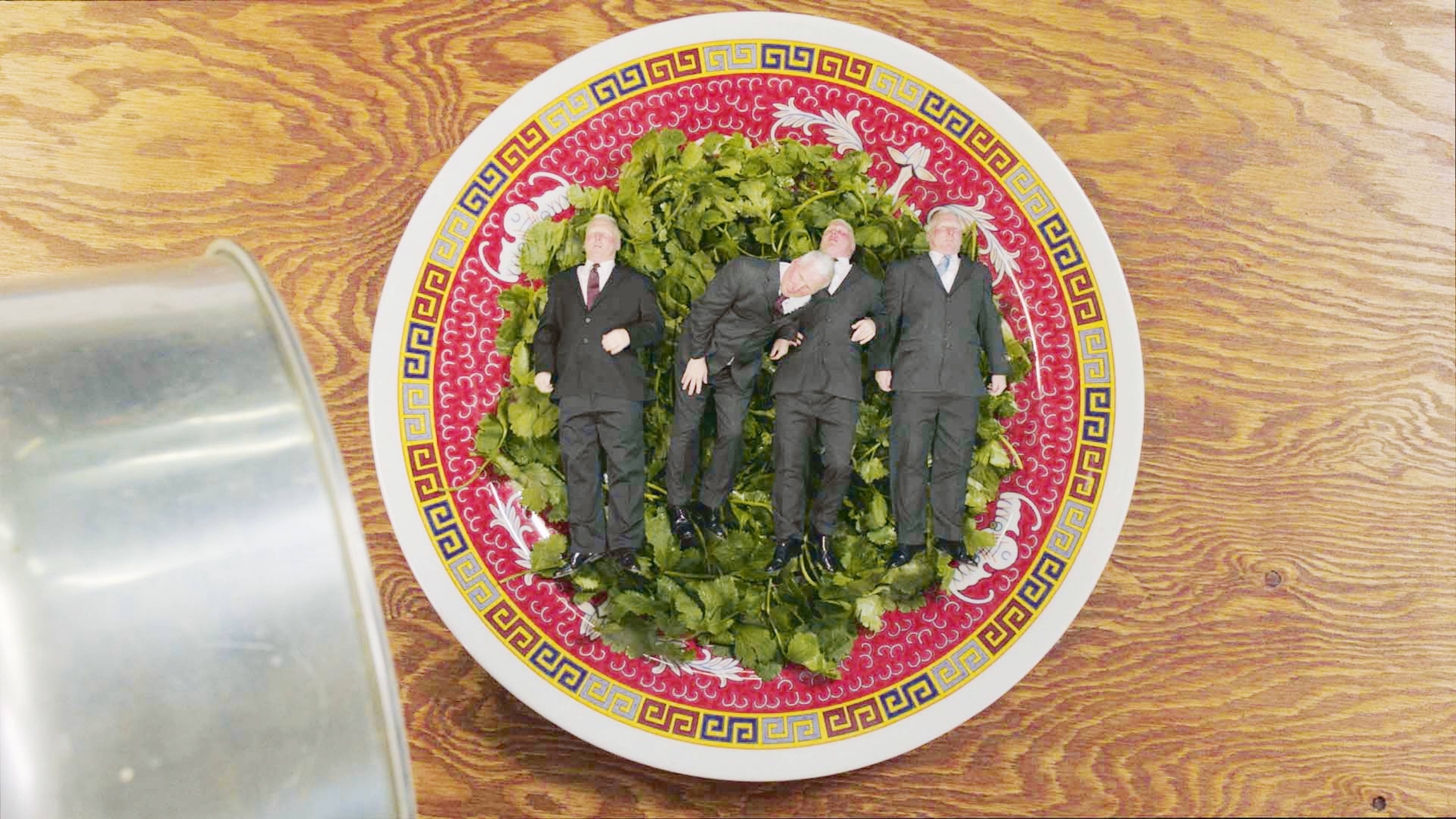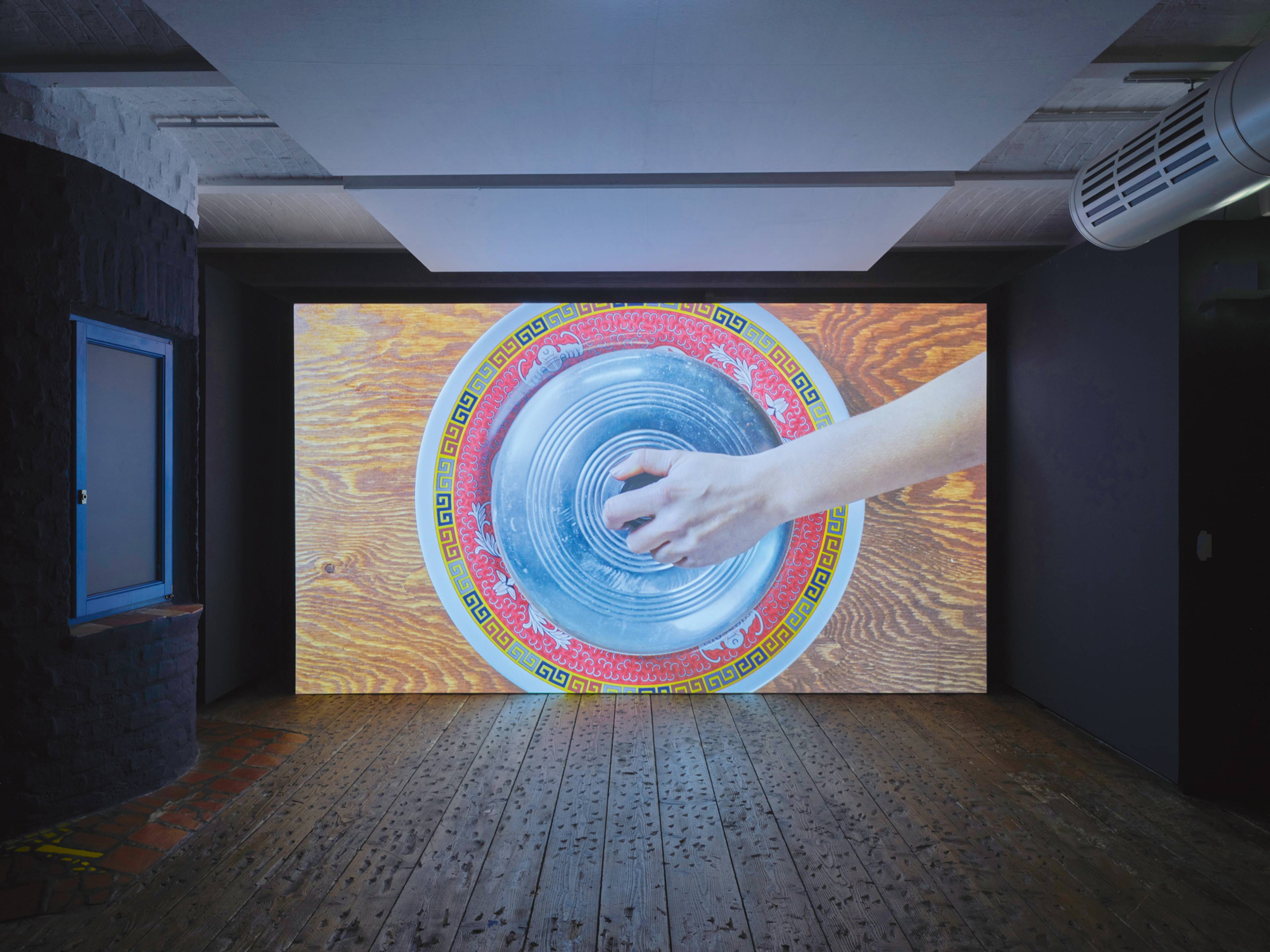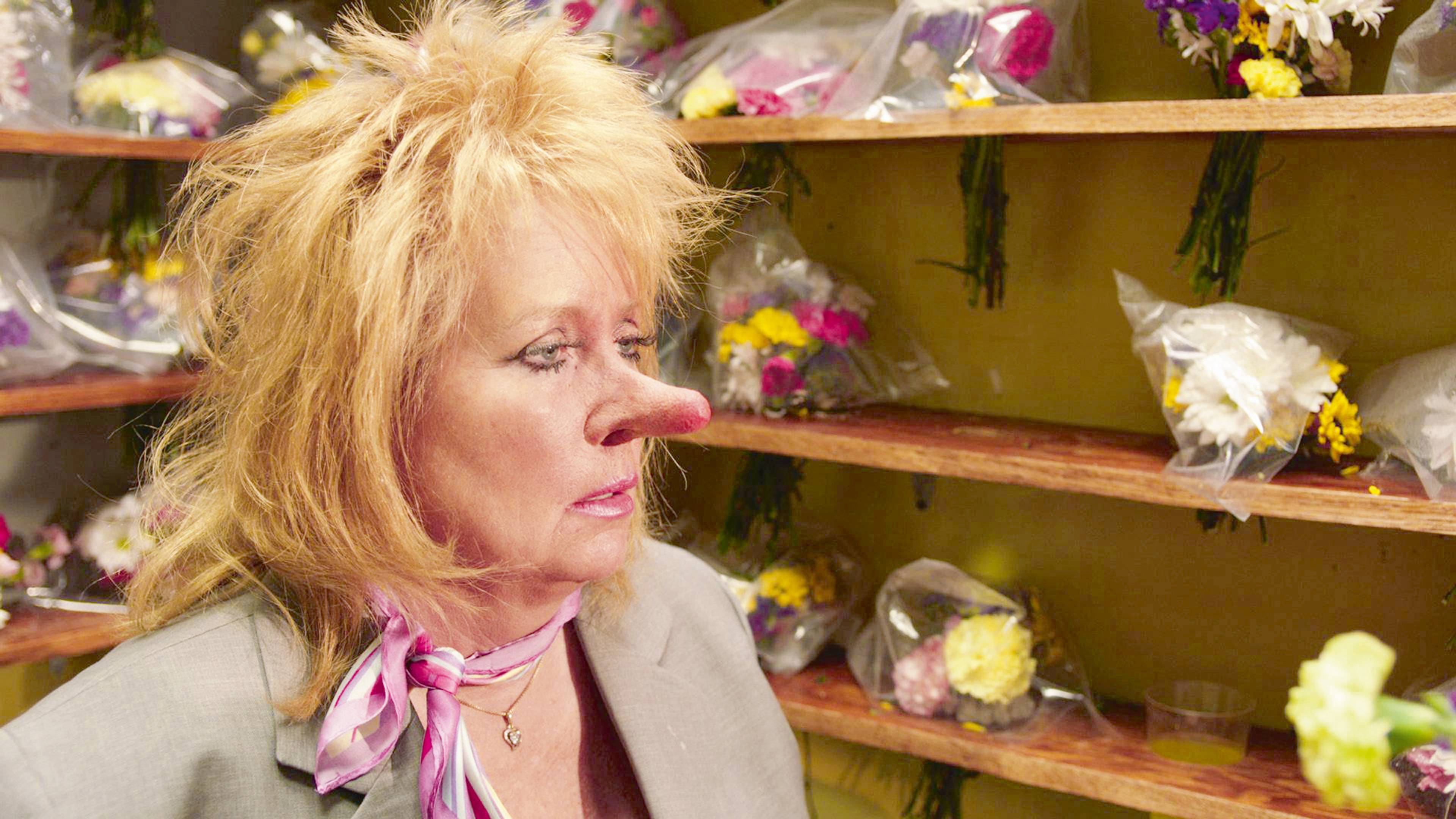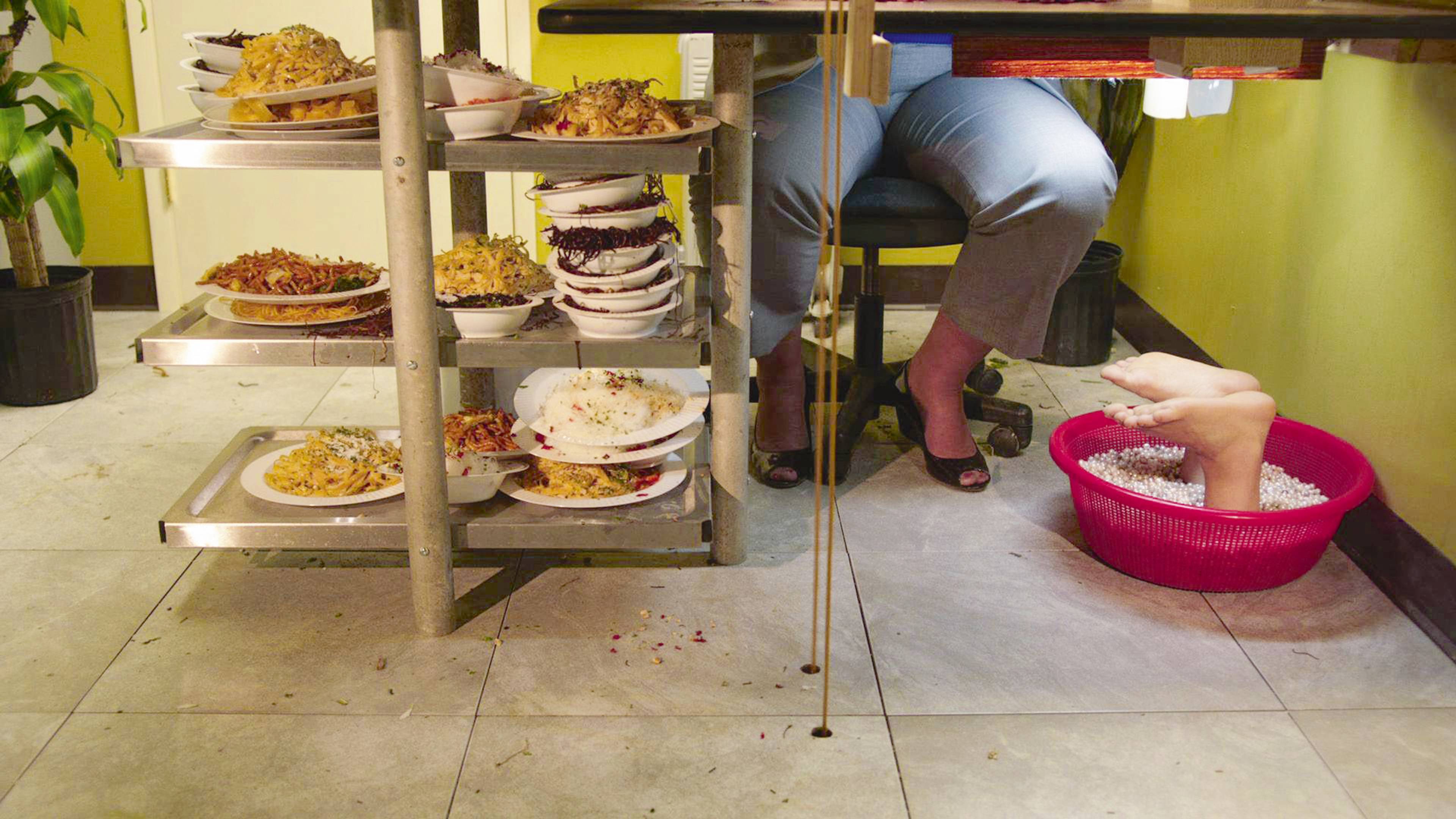You are what you eat, foodies love to say. It’s a truism that artist Mika Rottenberg (*1976) has jokingly flipped on its head, in works that imagine bodies, not devouring food, but excreting it. In her absurdist video Sneeze (2012), men expel steaks from their unnaturally long noses, along with fluffy rabbits and lightbulbs – all seemingly without effort, except for a stubborn facial tingle, their arched toes scratching the floor. With this comical scenario, Rottenberg brings out the fact that, as with most goods produced in the capitalist system, we rarely know the complex labor chains that bring them to our table; it’s as if products, including foodstuff, just miraculously appear, “sneezed out” ready for consumption. In this sense, her videos feature food, among other commodities, mostly as metaphors for current global problems, from China’s monopoly on and the West’s addiction to cheap stuff, to the drudgery of sweatshop labor.
Still from Cosmic Generator, 2017. Installation view, “Antimatter Factory,” Kunst Haus Wien, Vienna, 2025. Photo: Pete Mauney
In NoNoseKnows (2015), Bunny Glamazon plays a worker at a Chinese factory, where women painstakingly extract pearls from oysters while the real-life fetish performer sits alone in her cubicle, sniffing flowers until her schnoz reaches Pinocchio-like proportions. She, too, sneezes out a fully prepared dish, an endless variety of icky, oily noodles piling up, plate after plate, with no apparent customers. Rottenberg juxtaposes the effortlessness of Glamazon’s job – the colorful sparkles emitted from her nose before she sneezes – with the laborious cracking of oyster shells and the bleak surroundings in which this work takes place. But Glamazon is hardly what you’d call a happy manager: Her expression is blasé, while the relative inertness of her body is made all the more striking when juxtaposed with the ceaseless movements of the Chinese women’s hands, tirelessly sorting out pearls on an assembly line, or the precise movements of the workers who use metal instruments to induce oysters to produce those pearls inside their shells.
In Cosmic Generator (2017), one man dressed up in a tortilla outfit, another in a business suit, crawl through tunnels, only to end up on a plate in a Mexican Chinese restaurant. The film’s release coincided with the start of Trump’s first presidency, but Rottenberg skirts the issue of immigration to focus further on the global appetite for Chinese exports – she captures scenes of women working in the stalls at Yiwu Market, the world’s largest small commodities exchange, and shows Mexicali and Calexico, an agglomerated city split in two by the Mexico-US border. The tunnels act as fantastical connectors between these three places, serving as a metaphor for the global circulation of goods, but in the film, it’s mostly the Yiwu Market vendors who warrant our attention, their weary faces nearly lost in their stalls’ sea of glittery trinkets.
Stills from NoNoseKnows, 2015, single-channel video, color, sound, 22 min.
Occasionally in “Antimatter Factory,” I sensed a tinge of unrealized utopia. In one scene in NoNoseKnows, for instance, a young factory worker falls asleep at a table strewn with freshly sorted pearls. Her feet, dipped in a gemfilled bucket, reappear by Glamazon’s desk, suggesting that the latter’s effortless sneezing might just be the exhausted worker’s dream. Food is also a vehicle for reverie in Cosmic Generator, in which passersby gazing inside a street vendor’s dishes seem bewitched, their eyes widening as if they’d seen something extraordinary – some catching their reflections with sparkles swirling around the vendor’s boiling pot, whose round shape also resembles the tunnels.
For the most part, however, the logic of food in Rottenberg’s films succumbs to maximizing profit through the cheapest means, namely artificialization. In her three-channel video installation The Spaghetti Blockchain (2019), the artist interpolates images of organic food (for instance, eggs) with those of dubiously nutritious, candy-colored, jello-textured roulades – combined with closeups of machinery at the CERN facility in Switzerland, warbling throat singers in Siberia, and Maine potato farms. The foodstuff in particular undergoes constant metamorphosis: It burbles, melts, evaporates. The film collates images like a tin kaleidoscope, reshuffling matter in new colorful patterns, as if to say that, when it comes to mass-produced goods, it’s all pretty much the same.
Still from Spaghetti Blockchain, 2019, single-channel video, color, sound, 18 min.
Rottenberg couldn’t ask for a better venue than Vienna’s KunstHaus. In a white-cube space, her deliberately goofy videos might seem overindulgent; but the architectural style of the Viennese Haus, designed by the visionary Austrian artist Friedensreich Hundertwasser Regentag Dunkelbunt, is so wildly bric-a-brac that it normalizes Rottenberg’s propensity to excess. Its quirky biomorphic design, with patchwork tiles and colorful ceramic columns, underscores the childlike wonder in her work. The day I visited, school children in one video room were learning about the environmental dangers of plastic. And it felt like they may instinctively get Rottenberg’s ease in collapsing the real and the virtual, if not yet the earthly and the cosmic. After all, to these kids, the food chain is already halfway dematerialized: Less a rustic farm in Maine than tap-to-order on Uber Eats.
___
“Antimatter Factory”
Kunst Haus Wien, Vienna
27 Feb – 10 Aug 2025






